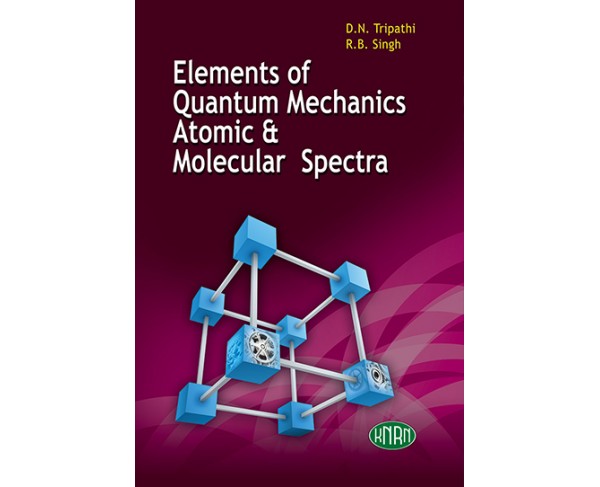Elements Of Quantum Mechanics, Atomic And Molecular Spectra
- Rs.300
- Ex Tax:Rs.300
- Brand: D.N. Tripathi, R.B. Singh
- Product Code:A00257
- Availability:In Stock
UNIT-I. Chapter-1: Particle Nature of Radiation Photoelectric effect and Compton effect; 1.1. Inadequacy of Classical Physics; 1.2. Photoelectric Effect; 1.3. Photoe..
Tags: elements of quantum mechanics, atomic and molecular spectra
UNIT-I.
Chapter-1: Particle Nature of Radiation Photoelectric effect and Compton effect; 1.1. Inadequacy of Classical Physics; 1.2. Photoelectric Effect; 1.3. Photoelectric Cells; 1.4. Compton Effect; 1.5. Dual Nature of Radiation- Bohr’s Complementary Principle; Solved Examples; Question and Problems; Objective Questions;
Chapter-2: Wave Nature of Material Particles: Wave-particle Duality (Matter Waves, Uncertainty Principle); 2.1.Wave-Particle Duality : de Broglie Hypothesis (Matter Waves); 2.2 Demonstration of Matter Waves—Davisson and Germer Experiment; 2.3. G.P. Thomson Experiment; 2.4. de Broglie wavelength of He atoms; 2.5. Bohr Quantization Condition; 2.6. Possible Energy states of a Particle in a Box; 2.7. Wave Velocity (or Phase Velocity);2.8. Group Velocity; 2.9. Phase Velocity (Wave Velocity) of de Broglie Waves; 2.10 Group Velocity of de Broglie Waves; 2.11 Heisenberg’s Uncertainty Principle; 2.12. Uncertainty Principle for Angular Momentum and Angular Position; 2.13. Application of Uncertainty Principle, Solved Examples, Questions and Problems, Objective Questions;
UNIT-II.
Chapter-3: Schrodinger Wave Equation; 3.1. Schrodinger Wave Equation; 3.2. Time-Dependent and Time-Independent Equation; 3.3. Interpretation of Wave Function; 3.4. Interpretation of Wave Function in terms of Probability Current Density; 3.5. Operators in Quantum Mechanics; 3.6 Angular Momentum operator; 3.7Eigenvalue Equation; 3.8. Orthogonality of Eigenfunctions of Hamiltonian Operator; 3.9. Compatible and Incompatible observables; 3.10. Commutator of Two Operators; 3.11. Commutation Relations; 3.12. Expectation Value; 3.13. Ehrenfest Theorem; 3.14. Superposition of States; 3.15. Adjoint (Hermitian Conjugate) of an Operator;3.16. Adjoint of Product of Two Operators; 3.17 Self-Adjoint or Hermitian Operation; 3.18. Observables (Dynamical Variables); 3.19. Postulates of Quantum Mechanic; Solved Examples; Question and Problems; Objective Questions;
Chapter-4: Applications of Schrodinger Equation; 4.1. Potential Step or Step Barrier; 4.2. Penetration of Particle Through Rectangular Barrier (Quantum Tunneling); 4.3. Particle in a Rigid One-Dimensional Box (Infinite Potential Well); 4.4. Particle in a Three-Dimensional Box; 4.5. Particle in a Finite Square Potential; 4.6. Harmonic Oscillator (Parabolic Potential), Solved Examples, Questions and Problems, Objective Questions;
UNIT-III.
Chapter-5: Atomic Spectra and Atomic Model; 5.1. Spectrum; 5.2. Series Relationship in Atomic Spectra; 5.3.Rydberg-Ritz Combination Principle; 5.4. Alpha Particle Scattering; 5.5. Atomic Structure; 5.6. Rutherford’s Nuclear Model of Atom; 5.7. Bohr’s Quantum Model; 5.8. Hydrogen Spectrum; 5.9. Bohr Theory of Hydrogen Spectrum;5.10. Bohr Theory as Corrected for Nuclear Mass; 5.11. Spectrum of Deuteron; 5.12. Bohr Theory Applied to Single-ionized He atom (He+); 5.13. Sommerfeld Extension of Bohr Theory; 5.14. Extension and Ionization Potentials of Atom; 5.15. Franck-Hertz Experiment; 5.16. Bohr Correspondence Principle; Solved Examples; Questions and Problems; Objective Questions;
Chapter-6: Vector Model of Atom; 6.1. Orbital Magnetic Moment of Electron; 6.2. Larmor Precession; 6.3. Space Quantization of Atom;. 6.4. Electron Spin; 6.5. Coupling of orbital and Spin Angular Momentum—Vector Model of Atom; 6.6. Coupling of Angular Momenta; 6.7. Stren-Gerlach Experiment; 6.8. Lande g-factor in L-S Coupling; Solved Examples; Questions and Problems; Objective Questions;
Chapter-7: Atomic Spectra of Alkali And Alkaline Earth Atoms; 7.1. Alkali Spectra; 7.2. Absorption Spectra of Alkali Atoms; 7.3. Fine Structure in Alkali Spectra; 7.4. Spectra of Alkaline Earth’s; 7.5. The Great Calcium Triads; Solved Examples; Questions and Problems; Objective Questions;
Chapter-8: Electron Configuration and Periodic table of Elements); 8.1. Quantum Numbers Specifying the State of an Electron in an Atom; 8.2. Shell Structure of Atom; 8.3. Magnetic Moment of a Closed Shell; 8.4. Pauli Exclusion Principle; 8.5. Building up of Electronic Configurations; 8.6. The Periodic Table; Solved Examples; Questions and Problems; Objective Questions;
Chapter 9 : X-ray Spectra; 9.1. Continuous and Characteristic X-rays; 9.2. Characteristic X-rays Line Spectrum; 9.3Kossel Explanation of Characteristic X-ray Spectra; 9.4. Moseley’s law; 9.5. Fine Structure in X-ray Emission Spectra; 9.6. X-ray Absorption Spectra; 9.7. X-ray Spectra and Optical Spectra; Solved Examples; Questions and Problems; Objective Questions;
UNIT-IV.
Chapter-10: Types of Molecular Spectra And Molecular, Energy States; 10.1. Introduction; 10.2. Molecular Spectrum; 10.3. Molecular Energy States and Associated Spectra;
Chapter-11: Pure Rotational Spectra 304–315;11.1. Salient Features of Pure Rotational Spectra; 11.2. Molecule as a Rigid Rotator; 11.3. No Rotational Spectra for Homonuclear Molecules; 11.4. Pure Rotational Spectrum and Rotational. Raman Spectrum; Solved Examples;
Chapter-12: Vibrational-Rotational Spectra; 12.1. Salient Features of Near Infra-red (Vibrational-Rotational Spectra); 12.2. No Vibrational-Rotational Spectra for Homo-nuclear Molecule; 12.3. Diatomic Molecule as Anharmonic Oscillator; 12.4. Isotope Effect in Vibrational-Rotational Bands; 12.5. Fine Structure of Infra-red Bands, Solved Examples;
Chapter-13: Molecular Electronic States; 13.1. Electronic States of a Diatomic Molecules; 13.2. Symmetry Classification of Molecular Electronic State; Solved Examples;
Chapter-14: Molecular Electronic Spectra 338–348;14.1. Salient Features of Molecular Electronic Spectra; 14.2. Vibrational (Gross) Structure of Electronic Band. System in Emission; 14.3. Electronic Absorption Spectra of Diatomic Molecules; 14.4. Fine Structure of Electronic Bands; Solved Examples;
Chapter-15: Isotope Effect on Electronic Spectra; 15.1. Spectroscopic Differences and imilarities Between Isotopic Molecule;, Solved Examples; 15.2. Vibrational Isotopic Displacement in Electronic Band System;
Chapter-16: Raman Effect; 16.1. Raman Effect; 16.2. Quantum Theory of Raman Effect; 16.3. Raman Spectra and Molecular Structure; Solved Examples;
| Stream | |
| Stream | (B.Sc Part II Paper III) |
| Author | |
| Author | D.N. Tripathi, R.B. Singh |
| ISBN | |
| ISBN | 978-93-80803-65-4 |
| Pages | |
| Pages | 372 |


